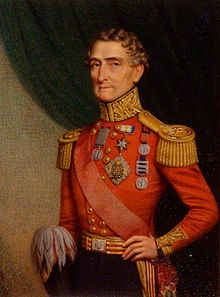Sir Harry Smith
| Sir Harry Smith, Bt | |
|---|---|
 |
|
| Born | 28 June 1787 Whittlesey, Cambridgeshire, Great Britain |
| Died |
12 October 1860 (aged 73) London, United Kingdom |
| Allegiance |
|
| Service/branch |
|
| Years of service | 1805 - |
| Rank | Lieutenant General |
| Commands held |
Western District Northern District |
| Battles/wars |
Napoleonic Wars War of 1812 Xhosa Wars Gwalior campaign First Anglo-Sikh War Battle of Boomplaats |
| Awards | Knight Grand Cross of the Order of the Bath |
| Relations | Juana María de los Dolores de León Smith |
| Website | Harrismith - Town Website |
Lieutenant General Sir Henry George Wakelyn Smith, 1st Baronet GCB (28 June 1787 – 12 October 1860), known as Sir Harry Smith, was a notable English soldier and military commander in the British Army of the early 19th century. A veteran of the Napoleonic Wars, he is also particularly remembered for his role in the Battle of Aliwal (India) in 1846, and as the husband of Lady Smith.
He was born in Whittlesey, Cambridgeshire, the son of a surgeon. A chapel in the town's St Mary's church was restored in his memory in 1862, and a local community college also bears his name: Sir Harry Smith Community College.
Harry Smith—for throughout life he adopted the more familiar form of his Christian name—was educated privately and was commissioned on 8 May 1805, and then promoted Lieutenant on 15 August. His first active service was in South America in 1806 during the British invasions of the Río de la Plata. He distinguished himself at the Battle of Montevideo in 1807, but first came to real prominence during the Peninsular War. Smith served throughout these campaigns with the 95th Rifles in which he served from 1808 through to the end of the war at the Battle of Toulouse in 1814. In 1810 he was appointed to ADC to Colonel Beckwith. Early in 1812 on 28 February he was promoted Captain, having already the previous March joined the 2nd brigade Light Division as major to the Major-Generals staff. On 7 April the day following the storming of Badajoz a well-born Spanish lady, whose entire property in the city had been destroyed, presented herself at the British lines seeking protection from the licence of the soldiery for herself and her sister, a child of fourteen. The latter, Juana Maria de Los Dolores de León, had but recently emerged from a convent; but notwithstanding her years she was married to Harry Smith a few days later. She accompanied him throughout the rest of the war.
...
Wikipedia
